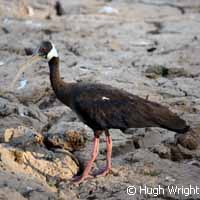Census offers hope for endangered ibis
The global population of the rare white-shouldered ibis (Pseudibis davisoni) stands at no less than 429 individuals, which is 30% higher than previous estimates, new research reveals. The discovery raises hopes that this critically endangered species will escape extinction. However, conservationists warn of continued threats to this beautiful bird. White-shouldered ibis were once found throughout much of South-East Asia. But deforestation, the drainage of wetlands for agriculture and hunting, have brought the bird to the brink of extinction, making it the most endangered water bird in South-East Asia. It has disappeared from southern China, Malaysia, Myanmar, Thailand and Vietnam. Today, some 90% of the global population can be found in the dry deciduous forests of northern and eastern Cambodia; the remaining few birds reside in southern Laos and East Kalimantan in Indonesia. In this latest study, researchers and conservationists led by the University of East Anglia (UEA) in the UK surveyed 37 roost sites across Cambodia. In total, the team counted 429 birds, 30% more than the IUCN (International Union for the Conservation of Nature) estimate of 330 birds. The team believes that the true population size could be even higher. 'During this record-breaking count, one of our main sites actually had far fewer birds than in previous surveys. I don't believe these birds move very far and they were probably still present at that site,' commented UEA doctoral student Hugh Wright. 'Considering previous counts, this means that the actual population could even exceed 500 birds. Discovering so many white-shouldered ibis really improves our chances of saving the species.' However, although the population is larger than suspected, this does not necessarily mean that the population is growing. 'It's unlikely that the population has actually grown or started recovering. We have put more effort into searching for ibis and we're getting better coverage of roost sites, hence our larger counts,' explained Sum Phearun, project assistant at the People Resources and Conservation foundation (PRCF) in Cambodia. 'But the species is still very close to extinction so we are continuing our efforts to understand and protect the ibis.' The study also sheds light on the distribution of the ibis in Cambodia; it was found that over 170 birds, equivalent to up to 40% of the known population, are living at the Lomphat Wildlife Sanctuary. This makes the sanctuary the second most important site in the world for white-shouldered ibis conservation, the leading site being the Western Siem Pang Important Bird Area (IBA), which has a population of over 200 birds. Meanwhile, the conservationists caution that the future of these birds is far from secure. Many birds live outside Cambodia's system of protected areas and the species' habitat remains under threat from plantations, agriculture and infrastructure projects. For example, the proposed Lower Srepok 3 dam would flood much of the Lomphat Wildlife Sanctuary, while the Western Siem Pang IBA is at risk of logging and being converted into plantations. Standing up to 85 cm (centimetres) tall, the white-shouldered ibis is dark in colour and sports a distinctive pale collar. It typically inhabits wetlands and grasslands, as well as deciduous forests. It feeds largely on amphibians and small invertebrates, among other creatures. During the wet season, the birds flock together at feeding and roosting sites, making it possible for conservationists to count them.
Countries
China, Indonesia, Cambodia, Laos, Myanmar/Burma, Malaysia, Thailand, United Kingdom, Viet Nam



